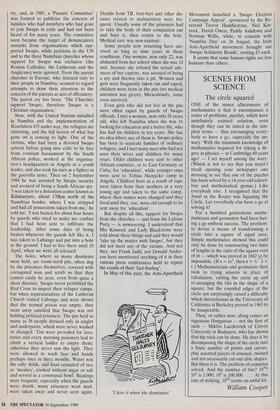SCENES FROM SCIENCE
The circle squared
ONE of the minor allurements of mathematics is that it encompasses a roster of problems, puzzles, which have indefinitely resisted solution, even though they can be stated in the sim- plest terms — thus encouraging every- body to have a go, especially the un- wary. With the minimum knowledge of mathematics required for taking a de- gree in physics— at Cambridge 60 years ago! — I set myself among the wary. (Which is not to say that you mayn't recall opening your newspaper one morning to see that one of the puzzles has been solved by a 14-year-old school- boy and mathematical genius.) Like everybody else, I recognised that the Jewel in the Roster was Squaring the Circle. Let everybody else have a go at solving it!
For a hundred generations mathe- maticians and geometers had been hav- ing a go without success. The problem: to devise a means of transforming a circle into a square of equal area. Simple mathematics showed this could only be done by constructing two lines of lengths in the ratio of the square root of pi — which was proved in 1882 to be impossible. (If x = 7rr2, then x = .\/r r.) Mathematicians and geometers then took to trying scissors in place of calculation, cutting the circle up and re-arranging the bits in the shape of a square; but the rounded edges of the circle not surprisingly raised a difficulty which theoreticians in the University of California at Berkeley proved in 1963 to be insuperable.
Then, or rather now, along comes an ingenious Hungarian — not the first of such — MiklOs Laczkovich of Eotvos University in Budapest, who has shown that the trick can be done. He does it by decomposing the shape of the circle into a finite number of points and curves, plus assorted pieces of unusual, twisted and not necessarily cut-out-able shapes. But there it is. The problem of centuries solved. And the number of bits? 105°! 103 is 1,000; 105 is 100,000. . . . At this rate of striking, 105° seems an awful lot.
William Cooper


































































 Previous page
Previous page